#Terminal studs
Explore tagged Tumblr posts
Text
Understanding Terminal Studs in Aviation: Applications and Types
In the highly specialized world of aviation, every component, no matter how small, plays a crucial role in ensuring the safety and efficiency of aircraft operations. One such essential component is the terminal stud. These sturdy connectors are integral to the electrical systems of aircraft, providing reliable connections that are vital for various functions. This blog will explore the applications and types of terminal studs used in the aviation industry.
Applications of Terminal Studs in Aviation
Terminal studs are primarily used to create secure electrical connections in an aircraft's wiring systems. Their robust design ensures they can withstand the harsh conditions encountered during flight, such as vibration, temperature extremes, and exposure to various chemicals. Here are some of the critical applications of terminal studs in aviation:
Power Distribution: Terminal studs are central to power distribution systems within an aircraft. They facilitate the connection between power sources, such as batteries or generators, and the various electrical components that require power. This includes everything from avionics systems to cabin lighting.
Grounding Systems: Effective grounding is essential for the safe operation of an aircraft's electrical system. Terminal studs are used to connect grounding wires to the aircraft's structure, ensuring that any stray electrical currents are safely dissipated.
Engine Systems: Modern aircraft engines rely heavily on electronic controls and sensors. Terminal studs are used to connect these components, ensuring reliable communication between the engine and the aircraft's central control systems.
Avionics: Avionics systems, which include navigation, communication, and flight control systems, require highly reliable electrical connections. Terminal studs provide the necessary stability and conductivity for these critical systems.
Maintenance and Inspections: Terminal studs are also designed to facilitate easy maintenance and inspections. Their robust nature means they can be connected and disconnected multiple times without degrading performance, which is crucial for routine checks and repairs.
Types of Terminal Studs in Aviation
Terminal studs come in various types, each designed to meet specific requirements and standards. The following are some common types of terminal studs used in aviation:
Standard Terminal Studs: These are the most common type and are used for general electrical connections. They are made from materials like brass or copper, which provide excellent conductivity and corrosion resistance.
Insulated Terminal Studs: These studs have an insulating layer that prevents accidental electrical contact with other components. This is particularly important in areas where space is limited and there is a risk of short circuits.
High-Temperature Terminal Studs: Aircraft often operate in extreme temperatures, so high-temperature terminal studs are designed to withstand these conditions without degrading. They are typically made from materials like stainless steel or nickel alloys.
High-Strength Terminal Studs: In applications where mechanical strength is critical, such as in engine systems, high-strength terminal studs are used. These studs are made from robust materials and are designed to withstand significant mechanical stresses.
Quick-Connect Terminal Studs: For applications that require frequent connection and disconnection, quick-connect terminal studs are ideal. They feature a design that allows for fast and secure connections without the need for tools.
Specialty Terminal Studs: Some terminal studs are designed for specific applications, such as those used in avionics systems or for grounding. These specialty studs may have unique features or be made from specialized materials to meet the stringent requirements of their specific applications.
Conclusion
Terminal studs may be small, but their importance in aviation cannot be overstated. They ensure that an aircraft's electrical systems are reliable, safe, and efficient, playing a vital role in everything from power distribution to avionics. By understanding the different types of terminal studs and their applications, aviation professionals can make informed decisions that enhance the performance and safety of their aircraft.
For more information on high-quality terminal studs and other essential aviation components, visit AOG Unlimited, your trusted partner in aviation solutions.
0 notes
Text
High-Quality Stud Type Terminal Blocks - Elmex Electric Pvt. Ltd.
Discover Elmex Electric Pvt. Ltd.'s superior Stud Type Terminal Blocks designed for robust performance and reliability. Our Stud Type Terminal Blocks are ideal for industrial applications, ensuring secure connections and easy maintenance. Explore our innovative Nut Driver Operated Stud Type Terminal Blocks that streamline installation and enhance efficiency. Trust Elmex Electric Pvt. Ltd. for premium quality and unmatched durability in electrical connectivity solutions. Stud Type Terminal block, Stud Type Terminal Block Nut Driver Operated, Electrical company.
Elmex Electric Pvt. Ltd. Add : 12, GIDC Estate, Makarpura, Vadodara -390010, Gujarat, India Ph : 02652642021 / 23 Mo : (+91)8905403005 Fax : 02652638646 mail : [email protected] Visit us at : https://elmex.net/ (+91)8905403006, (+91)8905902016
Facebook : https://www.facebook.com/ElmexControls/ Twitter : https://twitter.com/elmexcontrols LinkedIn : https://www.linkedin.com/company/elmex-controls-pvt.-ltd. Youtube : https://youtu.be/LOooD_SvEMo
0 notes
Text
prev post is literally felicity in my head.. this is him. he's literally that
1 note
·
View note
Text
Arms and Armor of the Hallstatt Celts: A (not-so) Brief Overview
The Hallstatt culture is an archaeologically-defined material culture group. The typesite for this group is in Hallstatt, Austria, where a deep salt mine which had been in use since the Neolithic served as the lifeblood of the local community. A substantial cemetery of approximately 1,300 burials near the mine has helped to clearly define artistic trends associated with this cultural group. The culture is associated with early Celtic or proto-Celtic language speaking groups, and for a long time, was thought to have been the origin of the proto-celtic language. This idea has since been debunked, as it is now known the first proto-Celtic speakers predated the Hallstatt culture.
The Hallstatt culture is divided into four phases, A-D (henceforth abbreviated as Ha. A-D). The first two of these phases are associated with the end of the bronze age in the region, the last two, with the beginning of the iron age.

Since the defining of the culture in 1846, Hallstatt influence has been found from Eastern France to Hungary, as far south as Serbia and as far North as Poland. The core Hallstatt region covers much of Austria and Southern Germany. By the Ha. C period, distinct practices had arisen in the Hallstatt sphere of influence: distinct enough for academics to split the culture into two “zones”, the East and the West.

Unfortunately, due to the antiquity of this culture and the utter lack of any written records concerning them, the archaeological record is both relatively thin, and the only source of information available for these people. As such, in constructing a timeline of Hallstatt arms and armor, there will be substantial gaps which we can only hope will be filled by future discoveries.
Armor
Three types of armor are commonly found in Hallstatt contexts: belts, cuirasses, and helmets.
That broad belts (both of leather and of bronze) are considered armor in the ancient Mediterranean is clear from references in which these items are placed in context with other armor. In the Iliad, for example, in book 7 after Ajax and Hector meet on the field of battle and fight to a stalemate, they exchange equipment. Hector “gave over his silver-studded sword, bringing with it the sheath and well-cut baldric” (l. 303-304), while Ajax reciprocated with “his war-belt bright with crimson” (l. 305). Additionally, a short list of military equipment issued by the Neo-Assyrian empire recovered in Tel Halaf lists 10 leather belts alongside bows, swords, spears, and other arms and armor.
A number of bronze and gold belt plates survive from both the Eastern and Western zones, though most of these plates date to the Ha. D period.
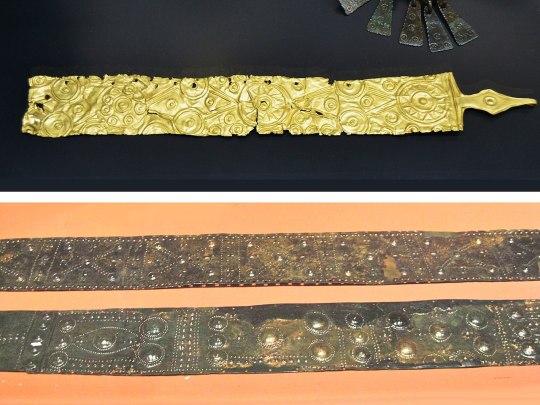
While the majority of these plates are decorated with embossed and incised geometric patterns, some (particularly from the Eastern zone) include scenes of warriors on foot and on horseback.
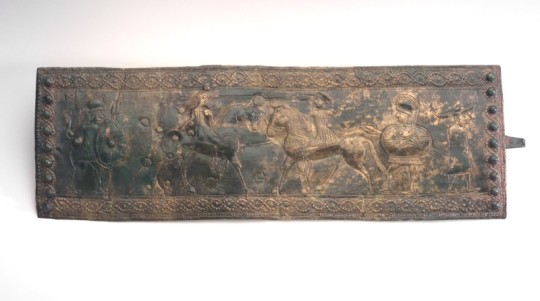
The cuirasses of the Hallstatt period exhibit an interesting progression. In their most basic form, these bronze cuirasses remain essentially the same from Ha. A-D. They are characterized by essentially simple forms: a tubular breast and backplate which terminates at the waist and includes a tall standing collar to defend the neck. The earliest examples, however, include substantial embossed decoration in much the same manner as appears on the belt plates.
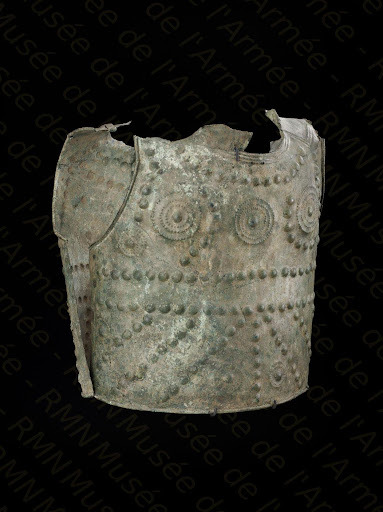
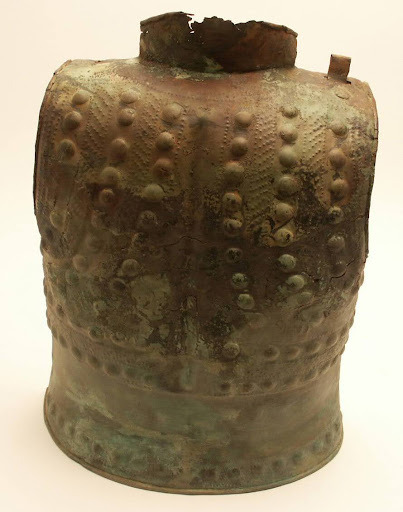
Only in the late Ha. B to early Ha. C period does this decoration begin to take on a more anatomical form; a group of seven cuirasses recovered in Marmesse, France in 1974 shows this evolution nicely. These cuirasses retain the same form, though a slight taper is now evident near the waist. The circular embossing closely resembles that of the previous period, however embossed lines are now apparent, and the placement of the embossing is such as to evoke the musculature of the warrior wearing it.
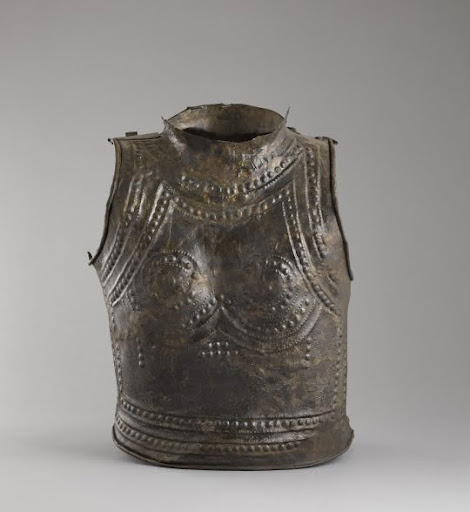

The final stage of the cuirasse’s evolution arrives in Ha. D. This form is much more plain, lacking the apparent horror vacui which typified earlier iterations of this style. Instead, the anatomical element is even more pronounced: embossing emphasizes the warrior’s pectoral and abdominal muscles, and additional circular bronze plates are riveted to the upper chest to simulate nipples.
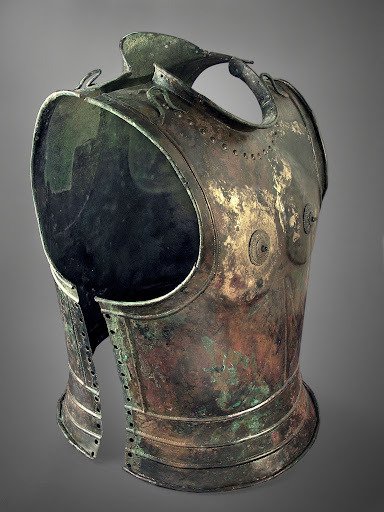
The final element of armor with substantial enough evidence in a Hallstatt context to be addressed is the helmet. Unfortunately, surviving helmets are extremely scarce, and there is no pictorial evidence to consult prior to the Ha. D period.
Four helmet types appear both archaeologically and artistically in Hallstatt contexts. We will call these the crested, the plated, the double-crested, and the Negau.
Only one artistic example of the crested helmet is to be found, and no archaeological examples. It is to be found on a grave good in the shape of a wagon adorned with many figures made ca. 600 BC and recovered in Strettweg, Austria.
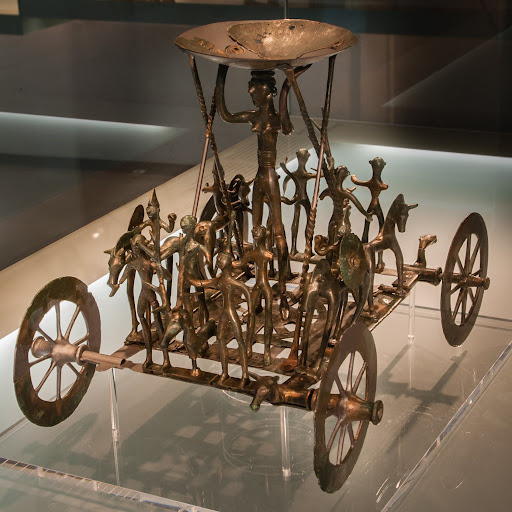
A find from Normandy (outside the Hallstatt sphere of influence) dated ca. 1200-700 BC shows what this type of helmet may have looked like.

The plated type is nearly as obscure, represented by only a single survival and a single artwork. The helmet, recovered in Šentvid, Slovenia and dated ca. 800-450 BC, is curious for the distinct pearly texture of its surface.
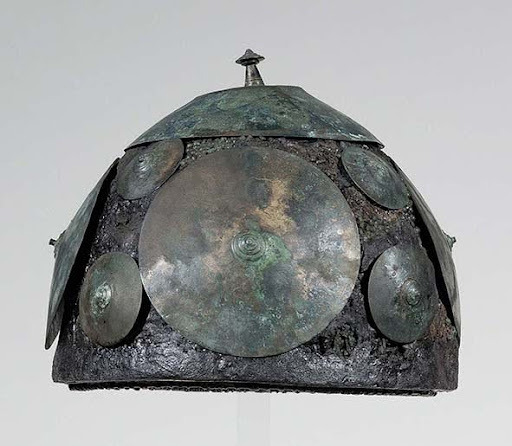
A number of similar helmets appear on a situla recovered from the Certosa Necropolis in modern Bologna, Italy. This situla is dated ca. 600 BC, and bears a striking resemblance to other situlae found in Hallstatt contexts.
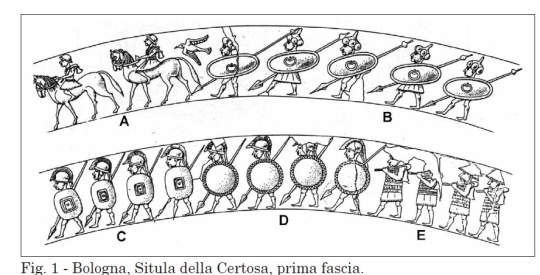
The most well attested form of Hallstatt helmet is the double-crested type. This type appears with the onset of Ha. D, and sees use until the end of the Hallstatt period. It is attested to by several survivals


and numerous depictions on a number of situlae
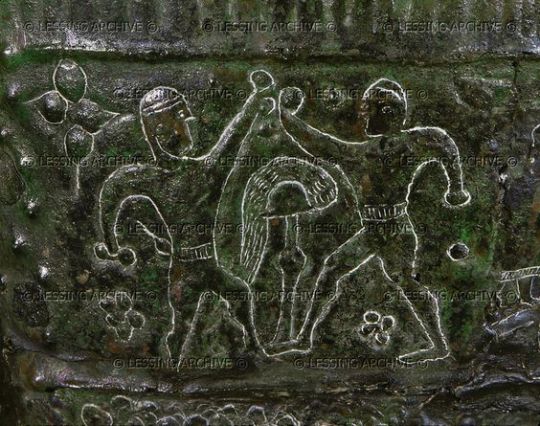
and belt plates.
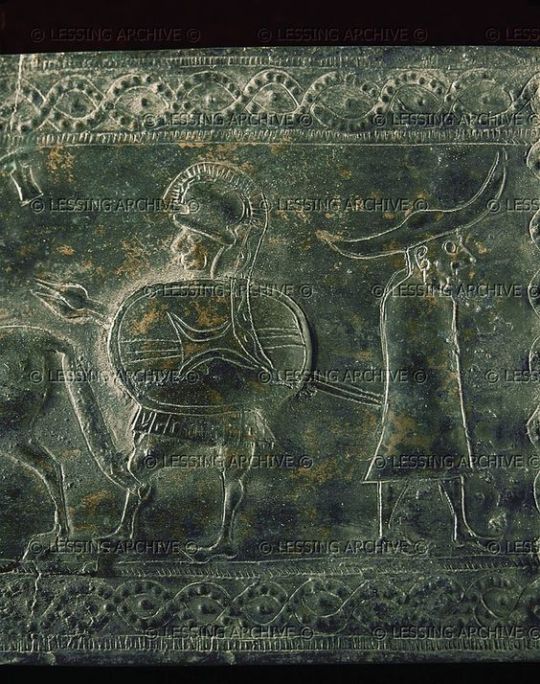
This type is so-called for the twin crests that adorn the helmet’s skull; crests which, as is attested by the pictorial evidence, served as anchors to large plumes likely made from horse hair.
The final type is named for a town in Slovenia where a large cache of helmets of this type was found in 1812. The Negau type appears at the very tail end of Ha. D, and primarily in Etruscan and Italic contexts. However a number of finds (including the eponymous horde) come from regions of Hallstatt (and eventually La Téne) influence.
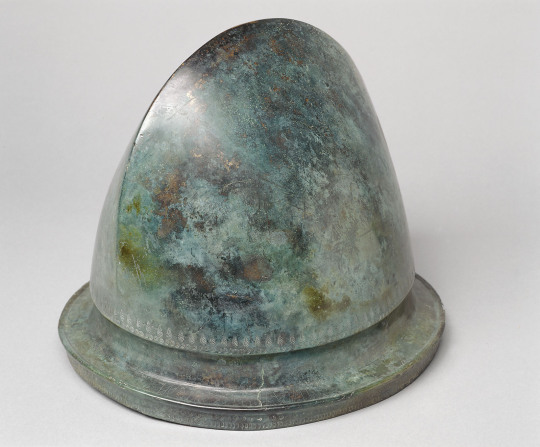
Weapons
The weapons which can be found in Hallstatt contexts are very much the same as those found elsewhere in Europe, consisting primarily on spears, axes, swords, and daggers. The spears and axes of the period are very similar to those found elsewhere in Europe and across the Mediterranean in the late bronze to early iron age, and as such will not be discussed further.


Indeed, even the swords of the Hallstatt bronze age (Ha. A-B) bear no significant differences from other swords found in Central and Western Europe at the time.
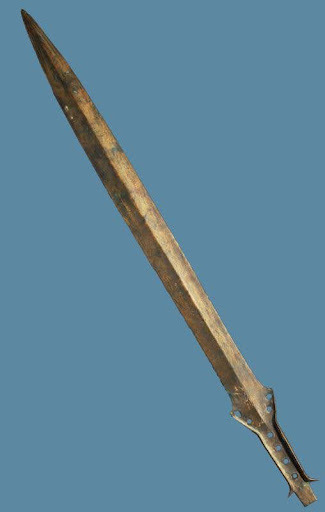
It is not until Ha. C, and the advent of the iron age, when two new types unique to the culture emerge. Though similar, these sword types, called Gündlingen
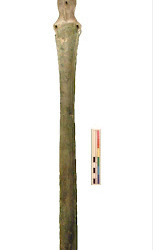
and Mindelheim, are distinguished by a number of factors.

First and foremost is size, with Mindelheim swords averaging around 85 cm or 33.5 in in length, while the Gündlingen type only averages 70-75 cm (27.5-29.5 in). Another striking feature of the Mindelheim type which is almost non-existent on Gündlingen swords is a pair of deep grooves on either side of the blade. Additionally, Gündlingen swords are only ever found in bronze, while Mindelheim can be found in either bronze or iron. Gündlingen swords seem to have been tremendously greater in popularity, with only 27 examples of the Mindelheim type being known to over 240 of the Gündlingen. There is also a geographical element: the majority of Mindelheim swords have been found in the east from Austria to Germany, Poland, and as far north as Sweden. Gündlingen swords, by contrast, have mostly been found in the west, as far as Britain and Ireland. Neither type, however, can be found in the core Hallstatt Regions after the advent of Ha. D, when daggers become the primary funerary good of the elite.
Daggers, of course, were not unknown in Hallstatt regions prior to 620 BC. A number of survivals from Ha. A-B attest to the fact that single-edged daggers were popular.

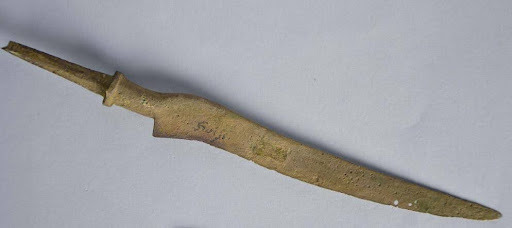
With the advent of the iron age and the rise in popularity of the peculiar Hallstatt sword types, daggers become more rare, until once again they spring back to the fore in Ha. D. At this time, a particular dagger type is almost ubiquitous. This dagger has long, straight quillons mirrored by a tubular pommel. The grip is thin, and the blade is broad and double-edged. This same basic form is present, both plain and with various embellishments, until the end of the Hallstatt period.

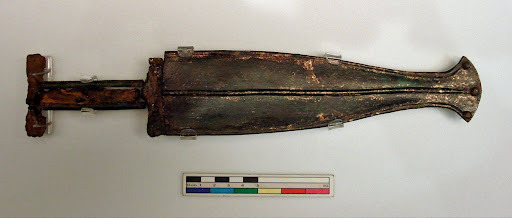
#arms and armor#weapons#armor#ancient history#hallstatt culture#celts#iron age#art#history#ancient celts#sword#axe#dagger#spear
147 notes
·
View notes
Photo

La Mode illustrée, no. 24, 17 juin 1883, Paris. Toilettes de Mme Coussinet, rue Richer, 43. Collection of the Rijksmuseum, Netherlands
Description de toilettes (Bibliothèque Forney):
Toilette de promenade. En taffetas glacé gris de lin et crêpe de Chine pareil. Jupe de dessous en taffetas garnie de trois volants plissés découpés en feuilles de rose. Le corsage, fait en forme de polonaise, est froncé devant, à l'encolure et à la taille où le retient une ceinture de ruban. La polonaise, fermée devant, est drapée jusqu'à la taille de façon à dégager la hanche, pour former un triple pouf derrière. Le corsage et la polonaise sont faits en crêpe de Chine, sans aucune garniture.
Robe en gaze-crépon crème et foulard broché Pompadour sur fond crème. Le devant de jupe, en gaze, disposé en deux bouillonnés-sacs, se termine en dents carrées retombant sur un large volant plissé. Redingote en foulard broché, tout à fait ouverte devant, retenue à la taille par une ceinture de ruban fixée par une boucle de métal (vieil argent). Les pans de cette ceinture se terminent par des ferrets en vieil argent. Le devant du corsage est rempli par un plastron froncé fait en gaze. Manches demi-longues. Gants très longs. Chapeau en dentelle crème doublé de rose.
—
Walking ensemble. In gray glazed linen taffeta and similar crepe de chine. Underskirt in taffeta trimmed with three pleated flounces cut out of rose leaves. The bodice, made in the form of a polonaise, is gathered in front, at the neckline and at the waist where it is held by a ribbon belt. The polonaise, closed in front, is draped up to the waist so as to release the hip, to form a triple pouf behind. The bodice and the polonaise are made of crepe de chine, without any trimmings.
Cream gauze-crepon dress and brocaded Pompadour foulard on a cream background. The front of the skirt, in gauze, arranged in two bubbled bags, ends in square teeth falling on a large pleated flounce. Brocaded foulard frock coat, completely open in front, held at the waist by a ribbon belt fastened by a metal buckle (old silver). The sides of this belt end with old silver studs. The front of the bodice is filled with a gathered plastron made of gauze. Half-length sleeves. Very long gloves. Cream lace hat lined with rose.
#La Mode illustrée#19th century#1880s#1883#on this day#June 17#periodical#fashion#fashion plate#color#description#rijksmuseum#Forney#dress#bustle#foulard#Modèles de chez#Madame Coussinet
230 notes
·
View notes
Text
Lavenique / Laveniq by thegenderthieves
a term for all black and mixed black lesbians
Continuing to repost some of my friends' stuff from their terminated accounts so that it's more easily findable (with their permission ofc) All text is pasted straight from the original coining!





Lavenique (lav-en-eek), also called Laveniq (lav-en-ick) is here!
It is designed for those that feel a disconnect from the lesbian label, typically due to the white-washing and white domination of lesbian history, and lesbian stereotypes - it’s open to use by any black or mixed black lesbian, and lavenique doesn’t gatekeep what lesbian as a term means unlike other terms, it’s all about your experience
Historically, black lesbians have been pushed out of lesbian spaces, many feeling completely excluded and choosing to use queer, sapphic, or gay as an alternative, so I wanted to make that alternative!
Black sapphics all participated in giving their input for the term! The symbol of a violet was the most popular option for a symbol, so there’s an optional variant of the flag using this symbol! Violets are symbol of lesbian love, given by sapphics to other sapphics as a symbol of being attracted to them
Stripe meanings:

I've also made black butch/stud, black femme, and black futch/stem flags
#coining post#sapphic#lesbian#pride flag#mogai#lgbtq#positivity#pride#queer#lesbian pride#lesbian flag#wlw#nblw#bulldyke#dyke#black dyke#black#poc#black joy#futch#new pride flag#flag coining#labrys#lavender menace#pride month#laveniq#lavenique#black lesbian#lesbian community#lesbianism
38 notes
·
View notes
Text
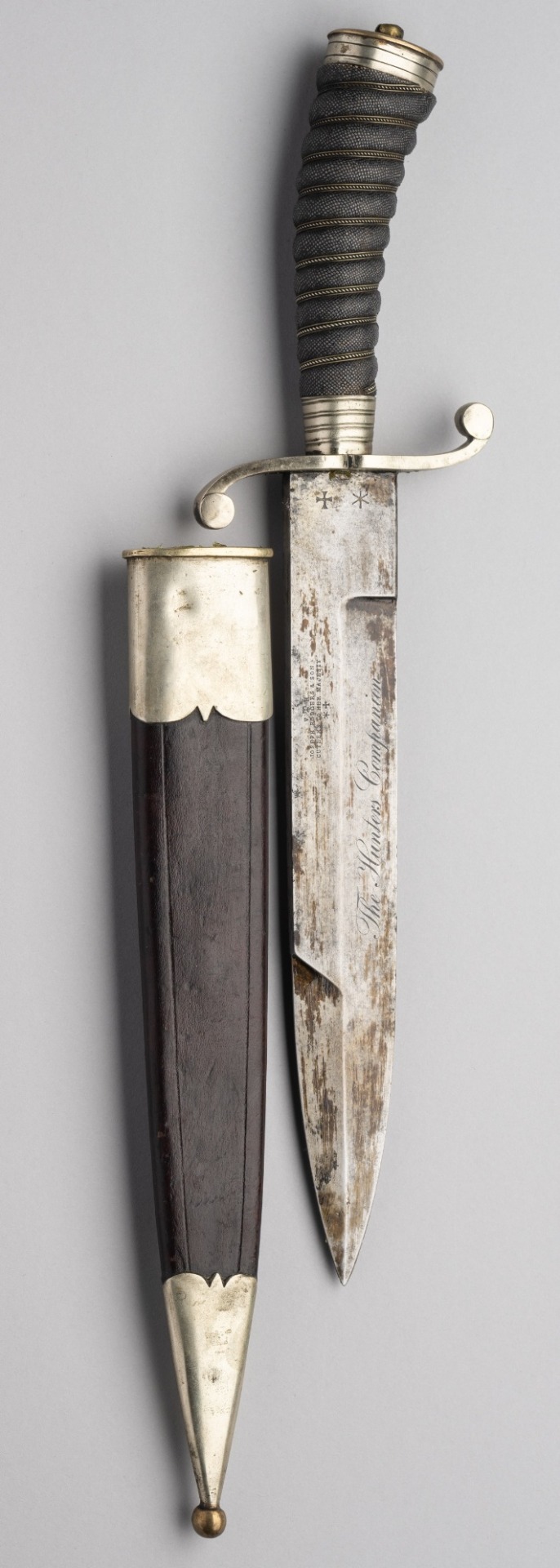
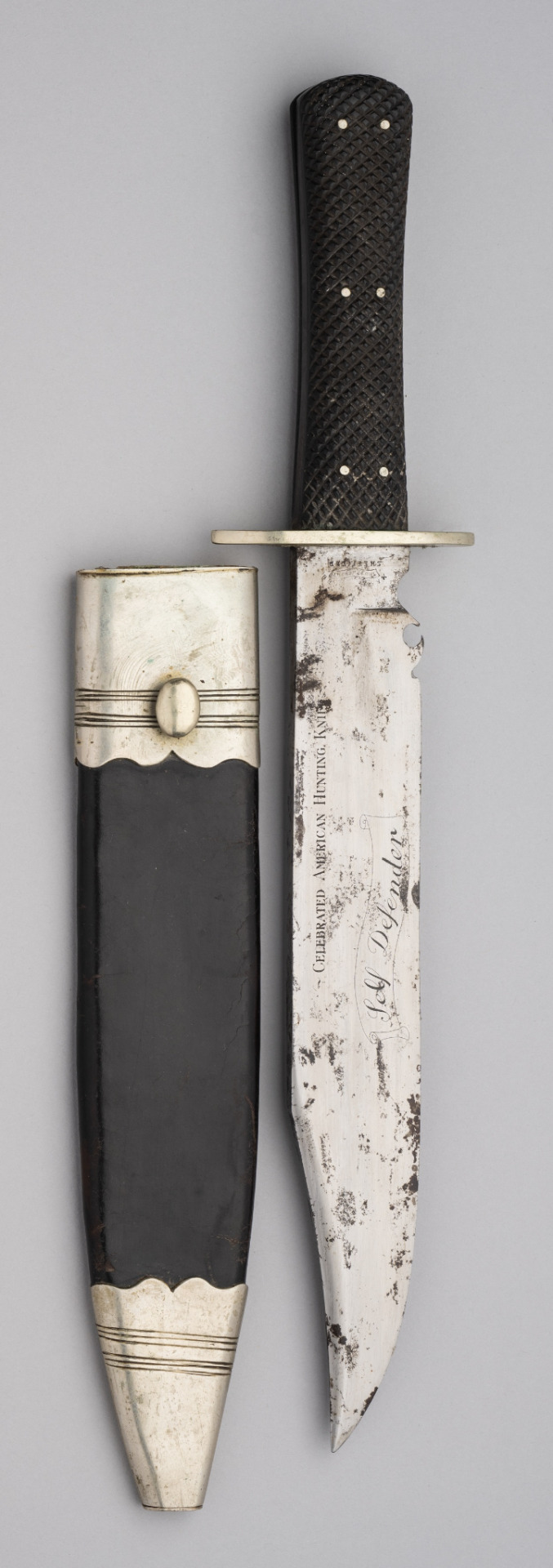




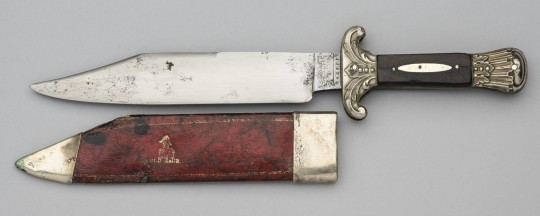



19th century Sheffield bowie knives
A HUNTING KNIFE, JOSEPH RODGERS & SONS CUTLERS TO HER MAJESTY, SHEFFIELD, CIRCA 1860 with tapering blade formed with a spear point, stamped with the maker’s details on one face, and ‘The Hunter’s Companion’ in script, rectangular ricasso struck with star and cross mark, German silver hilt comprising recurved quillons with flattened scrolling terminals, cap pommel (fitted with later copper alloy oval), and spirally-bound fishskin-covered grip, in its leather scabbard with German silver chape and locket, the latter with a belt hook, 23.5 cm blade
A HUNTING KNIFE FOR THE AMERICAN MARKET, MAPPIN & WEBB, SHEFFIELD, CIRCA 1880 with robust blade formed with a clipped-back point with false swage, notched at the forte, stamped ‘Celebrated American Hunting Knife’ in capital letters, ‘Self Defender’ in script on a scroll, rectangular ricasso stamped with the maker’s name and ‘Trustworthy’ on one face of the ricasso and ‘US’ on the other, German silver oval cross-piece and chequered horn scales retained by six rivets, in its German silver mounted leather scabbard with locket and chape each engraved with groups of three lines, and the former with a stud for suspension, 25.3 cm blade
A BOWIE KNIFE, LATE 19TH CENTURY with single-edged blade formed with a pronounced clipped-back point, etched with a Federal eagle and inscriptions on one face including ‘America The Land of Freedom’ and 'The Patriot’s Self Defender’, recessed ricasso stamped ‘Best Quality Rough & Ready’ German silver guard, ferrule and pommel, the latter chased with flowers, and rosewood grip, in its tooled leather scabbard, 19.8 cm blade
A SMALL BOWIE KNIFE, JONATHAN CROOKES, SHEFFIELD, LATE 19TH CENTURY with broad blade formed with a clipped-back point, recessed rectangular ricasso struck with the maker’s name and heart and pistol mark, German silver hilt comprising recurved guard, ferrule and pommel each decorated with scrolling foliage in low relief, and mother-of-pearl grip, in its German silver mounted leather scabbard with belt loop,14.5 cm blade
A BOWIE KNIFE, JONATHAN CROOKES, CIRCA 1880 with straight blade formed with a clipped-back point, slightly recessed rectangular ricasso signed by the maker and with heart and pistol mark, and natural staghorn grips (perhaps an early replacement), 15.3 cm blade
A BOWIE KNIFE, JOSEPH RODGERS & SONS, CUTLERS TO THEIR MAJESTIES, NO. 6 NORFOLK STREET, SHEFFIELD, LAST QUARTER OF THE 19TH CENTURY with broad blade formed with a clipped-back point, struck with the maker’s details and star and cross mark on one face (small areas of light pitting), oval German silver guard, and natural staghorn scales retained by five rivets, in its leather scabbard with large German silver locket and chape, 20.8 cm blade
A DAGGER, MARKED MAZEPPA, PROBABLY SAMUEL HANCOCK & SONS, LATE 19TH CENTURY with broad blade formed with a clipped-back point, recessed ricasso struck with a figure strapped to a horse’s back and ‘Mazeppa’ on one face, German silver hilt cast in low relief, comprising guard and pommel decorated with scrolls, milled copper alloy fillers and hardwood scales, in its tooled and gilt leather scabbard,17.2 cm blade
A BOWIE KNIFE, LINGARD, PEACROFT, SHEFFIELD, PROBABLY 1870 with single-edged blade formed with a clipped-back point and part swaged back-edge, rectangular ricasso stamped ‘Lingards Celebrated Bowie Knife Pea Croft, Sheffield’, German silver hilt comprising two-piece guard and pommel each cast with scrolls and foliage in low relief, brass fillets, staghorn scales, and vacant German silver escutcheon, 21.0 cm blade
AN ARKANSAS BOWIE KNIFE, MORTON & SON, SHEFFIELD, CIRCA 1850-60 with tapering blade of flattened-diamond section, recessed rectangular ricasso struck with the maker’s details (worn, partly illegible), German silver hilt comprising ‘split’ cross-guard and two-piece pommel each decorated with scrolls and foliage in low relief, and a pair of small bone scales retained by two rivets, 22.7 cm blade
A BOWIE KNIFE, WRAGG & SONS, SOLLY ST, MID-19TH CENTURY with broad double-edged blade, recessed ricasso signed in small stamped letters, German silver cross-piece and pommel, the latter cast with an alligator-horse on each face, and horn scales (restorations), in its tooled and gilt leather scabbard with German silver mounts, 30.8 cm blade
tinyurl.com/yr4hd4pr
156 notes
·
View notes
Text
one of my whackier beliefs is that people’s defense mechanisms overwhelmingly have a way of obscuring what their actual desires are.
my only real evidence for this is that I’ve never met anyone that I could confidently describe as “self-aware”. in relative terms, maybe. some people have a better instinct about this stuff than others do. but we all have blind spots, and frankly, tell ourselves small lies sometimes. “I was completely in the right here” and “I’m a worthless piece of shit” are both functionally thought-terminating cliches. being mean to yourself is paradoxically a defense mechanism because it details your train of thought. can’t think clearly about any situation when you’re emotionally worked up and fighting tears.
“but can you corroborate that with any stud–” no. it’s entirely speculative but I’m having fun.
42 notes
·
View notes
Note
I've got soooo many prompt in my Black Widow/Sugar Daddy AU!
Prompt 3 -- [Fishbowl Rescue] Burgess unhappily thwarted from getting Dream for himself, kidnaps him from Hob's protection.
Someone on Hob's staff, made a few terminal mistakes: (1) being on the take for Burgess, (2) thinking regardless of what their relationship might seem like to outsiders, that Hob wouldn't care if Dream was taken; and (3) that there was any situation where anyone, ANYONE, could take from HOB! Let alone take Hob's Dream.
Hob salts the EARTH with all that is, or was, Burgess - there are raging - actual - fires burning all over the world as Hob searches of Dream.
Dream was right, Hob is not a nice man, and Dream is his.
It's a given that Hob is going to kill everyone who touched his Dream, but if there is a mark on him that Hob didn't give him - the person who put it there is loosing whichever body part caused the injury, before Hob kills them.
Dream is pretty sure Hob will come for him (he hopes) if for no other reason than Dream knows Hob views him, at the very least, as his. He hold on to that hope, as Burgess leers at him, naked in this soundproof room surround by cameras; when Burgess puts his hands on him and threatens him with worse; as no one helps him. Dreams wishes(/hopes) for Hob.
Then Hob walks in the door, soot covered, bloody and so achingly beautiful, saying 'Hello, duck.'
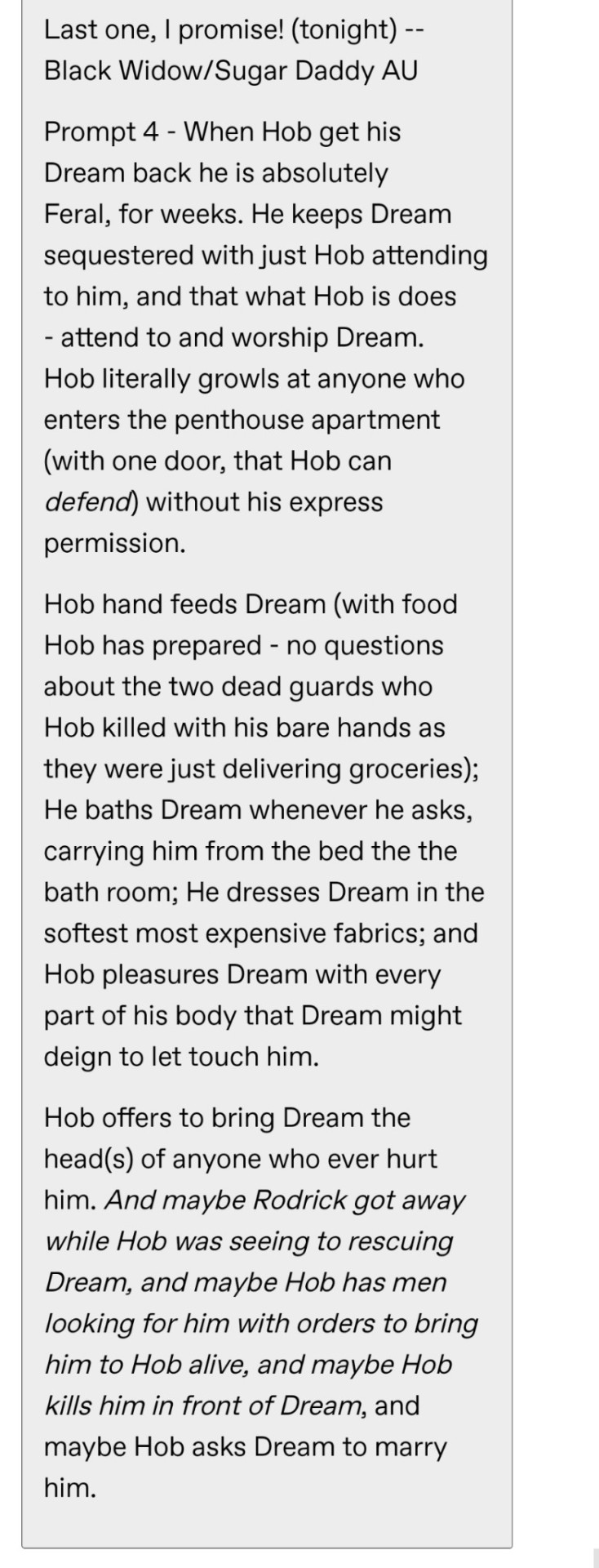
Here's the first part of your lovely black widow/sugar daddy au. And now we have more!! So wonderful!!
I ABSOLUTELY adore this version of Hob. To Dream he's the sweetest, most angelic man. He would do anything for Dream, would walk over hot coals for him and spend any amount of money to make him happy. He makes Dream laughs, makes him cum, and is generally the most darling man in the world.
To everyone else? Hob is not so nice. Particularly not to people who hurt his Dream. Generally Hob is happy to outsource his dirty dealings to his employees, but when it comes to Dream it's personal: he personally tortures his ex-staff member for information. He personally hands over money to contacts he's got across the world. He personally sets up the lines of explosives outside of Burgess's hideout.
When he finds Dream in that basement, he has to fight hard to contain his rage. Dream doesn't need to see that, he just needs Hob to get him out. It doesn't matter that Burgess gets away - it will give Hob greater pleasure to hunt him, in fact. The main thing is to get Dream out.
He immediately has the cameras in the room scrubbed and destroyed. And he has multiple staff members scouring all levels of the web in case the footage ever leaks. The basement and the entire place where Dream was kept are totally razed from the earth. Its like they were never there.
Dream is something of a mess, of course. But all he keeps saying is "I knew you would come." Hob has to hide his face and cry while Dream is sleeping because he's just so relieved that his most beloved is alive and reasonably well. Hob is absolutely 100% feral during Dream’s recovery and Dream loves it. He loves the way Hob kneels at his feet and kisses his ankles, worshipping him like a god, promising him in the world. For the first time ever, Dream actually believes. He believes that Hob loves him.
Dream spends a lot of time in the recovery period trying to reassert himself and regain his confidence, and Hob is so supportive. He lets Dream dominate and fuck him, lets him scream and shout. And they also just spend time touching each other under piles of soft blankets, safe and shielded from the world.
Maybe it's (literally) overkill to have Burgess's half-dead body prostated at Dream’s feet when Hob proposes, but Dream seems to like the gesture. Hob presents him with a ruby studded handgun, which Dream happily uses to finish Burgess off.
And he says yes, of course. Not for the money (although that is a bonus), not because he's going to get in the will and immediately dispose of his husband. But because no one can love him as Hob does. And Dream can't quite imagine living without him.
He still keeps the gun.
60 notes
·
View notes
Note
The Blackberry Bushes Book 3 Revision 2?
I think there's a bit of the incomplete chapter draft in this file that I haven't shared yet, in which Tamett enters Odren's study and we get our first impressions of the king and of the way that Tamett is treated as someone from a nation subjugated by Lienne:
He stood in a room of white marble beneath a high domed ceiling. Bookcases lined the walls, displaying books all the same size, bound identically in the deep blue and silver of the Liennese flag. White marble busts on Ionic pedestals peeked out from corners with pupilless stares. Tamett shuddered, half expecting them to quiz him in Greek with the voice of HRH’s tutor. A forest of blindingly white columns stretched toward the far end of the room. There, before an empty white fireplace, were chairs upholstered in studded navy leather, their unsociable slipperiness unrelieved by any cushion or rug. And beside the chairs, behind a fortress of a desk, awaited exactly the sort of man who would own such a room.
The king glanced up from his papers and said, “Come in,” in a low voice that seemed to shake the very dome.
Tamett inched across the rugless floor, studying its checkered pattern and wondering if the king had ever considered acquiring giant chessmen to match it.
He stopped a respectful few yards from the desk, head humbly down, and assumed the position of a Liennese bow. Right leg back, bobbing halfway down on the left leg, right hand over heart.
“My heart beats in your service, Your Majesty,” he said.
He was the chessman.
The king gestured for Tamett to rise but did not indicate that he could sit. Now that they were at eye-level, Tamett dared a closer look at his monarch. He had seen the king before, of course, but nearly always at a distance as His Majesty inspected his children or breakfasted with them or attended weekly recitals. The king had always reminded him of what HRH would probably look like in forty years. He had the same stabbing gray eyes, square jaw, and steel-rigid posture as his son, although his hair and beard were fairer than HRH’s and noticeably graying. Not even the vast, high-ceilinged room could dwarf him; even when seated, he was impressively tall, and rather stout, as HRH was promising to become. But where HRH boiled over with disdain at every flaw he beheld, the king looked as if he too had weighed his subject in the balance and found him wanting but couldn’t be bothered to regard him with more than distant reproach.
Like an insect on the floor. Like someone who was about to be dismissed and therefore could be no further concern.
The king rifled through the papers in front of him. Tamett steeled himself, sure that one of them would be the official termination of his employment. But the king only said, “You are the Låsrygg boy?”
“Yes, Your Majesty.”
“Tamett, is it?”
“Yes, sir.”
The king jotted something on a paper in thick, bold handwriting. Tamett wished he knew how to read upside-down.
“Our records indicate,” said His Majesty, “that you have been with us for more than five years now as my son’s companion. And frankly, Tamett, when your uncle recommended you, I never expected you to last this long. We wanted a boy of good Liennese stock. Engaging a Noriberian was a risk, especially if I wanted my son to learn hard work and reliability. But you have proven yourself. One would hardly know by now that you are Noriberian at all.”
He paused, awaiting a reaction.
“Thank you, Your Majesty,” said Tamett, once he realized that the king thought he was paying him a compliment.
“You are an example to your people. We are Liennese, the highest honor that God could grant us at our births, and all my subjects must remember that.”
Tamett was tempted to reply in Noriberian, but his father had always told him never to speak that language at the palace. Lienne had occupied Noriber for hundreds of years without a sign of ever yielding back sovereignty, and at this point, the best and safest thing that Noriberians could do was to assimilate, to convince the Liennese that they were as civilized and loyal as any other subject of His Majesty.
“Yes, sir,” said Tamett. At least “yes” in Liennese and Noriberian were identical. The king would never know which he had just heard.
The king smiled smugly at his subject’s gratitude for this gracious commendation. “I also had my concerns about how well you would get on with Prince Josia. My son is an exceptional child. He is the culmination of centuries of only the most careful breeding, designed to produce the strongest, the noblest, the most intelligent, the most physically perfect specimens of the sons of Lienne. As such, he has so little in common with ordinary children that his tastes have become extraordinarily discerning. Perhaps he is…just a trifle…shy. He does not easily take to most other children, which is why I insisted upon a schoolroom companion in the first place.”
Tamett had always supposed he had been engaged to better offset HRH’s superiority, but if the king wanted so badly to believe that he was fostering sociability in his poor bashful boy, one might as well let him.
“But somehow my son has grown rather fond of you.”
That was news to Tamett.
“One might say, even close to you. As close as one could be to a sort of subordinate brother. You are privy to every detail of his day-to-day life.”
Well, not every detail. Thank goodness he had never been expected to dress, feed, bathe, or otherwise physically tend to HRH.
“His progress reports have been nothing but satisfactory since you joined him. But would you agree, Tamett?”
Tamett shifted his weight. “I beg your pardon, sir. I don’t understand what you mean.”
“Would you agree that you have been a good influence on my son? That you have encouraged him to become everything that the Hope of Lienne should be? That you have taken part in building him into a future monarch who surpasses every other? That I should not regret bringing you into my household and bringing you up alongside my own children?”
“Er…,” said Tamett. Nothing more articulate could escape his throat. Every word in every language he had ever studied wiped itself from his brain.
The king offered him no further aid, just bored into him with those knife-colored eyes. Beads of sweat formed under Tamett’s stiff collar and dripped meanderingly down his back, but he stifled the urge to wriggle. Had he not forced himself to imagine his boots were nailed to the floor, he would have bolted out then and there.
The king seemed to be staring into his soul.
“I’m sorry!” cried Tamett at last.
The king’s eyebrow lifted a fraction of an inch. “For what?”
“For pinching—I mean, taking His Royal Highness’s napkin and sitting on it.”
“What—”
“Today. At the luncheon. And switching out my glass with his. Several times. And sneaking grapes off his plate.”
The King opened his mouth again, but Tamett, too wound up with the thrill of confession, didn’t notice.
“And knocking over the salt shaker into the jam tart. It was an accident. Mostly. And I shouldn’t have excused myself before it was over or taken so long to come back after I did, and I’m awfully—I mean, quite sorry, Your Majesty, and I won’t ever do it again, just please don’t tell my parents and please don’t dismiss me.”
9 notes
·
View notes
Text
Merovingian Era Terminals

A terminal is the decorative end of a brooch. Brooches come in many varieties and sizes, but always in two parts, the head: which is where the needle hinges, and the foot: where the needle is secured behind a hook or curved heel.
The head is often very eyecatching and well decorated. The foot is usually longer than the actual needle and most often tapers to the end, that little tapering end is the terminal.
Roman (military) brooches usually have some kind of stud or geometric element, while Merovingian and Anglo-Saxon brooches have rounded ends which are almost always shaped like a stylized animal head.
There are discussions amidst academics as to what animal is supposedly portrayed, but there is no consensus. Animal head terminals are found all over Europe.
Image: Anglo Saxon terminal (from unidentified larger artifact) from the Staffordshire Hoard. Photographed by “PA” for The Guardian (24/09/2009)
#frankish#merovingian#viking archaeology#archaeology#carolingian#charlemagne#field archaeology#viking mythology#merovingian archaeology#germanic mythology#norse mythology#anglo saxon#viking#field archaeologist#frisian#odin#vikings#germanic#germanic folklore#germanic archaeology#wodan#anglo saxon archaeology#history#jewelry#norse
22 notes
·
View notes
Text
Revolutionizing Connectivity: Stud Type Terminal Blocks by Elmex Controls Pvt Ltd
Introduction: In the realm of electrical engineering and industrial automation, the importance of efficient wire connectivity cannot be overstated. It forms the backbone of numerous systems, ensuring seamless transmission of power and signals. In this dynamic landscape, Elmex Controls Pvt Ltd has emerged as a frontrunner, pioneering groundbreaking solutions in wire connectivity.
0 notes
Note
The theater kid in me is about to come out in a way only an English professor could appreciate but
kirk whatshisname always plays minor roles in other shows, a few episodes on The Walking Dead and that one time on White Collar. Both times my man was a grade-A ASSHOLE. My boo thing was stone cold and also??? His voice is so deep like. damn.
He’s almost always an asshole and I love than bc Miguel is just the kindest soul ever. His eyes are so kind I’m 99% sure that makes sense. His accent is so soft and he’s so soft and he’s my lil guy okay leave my man alone
It’s such a drastic contrast and I think it’s proof his actor is just. mwah. Perfection.
also I started watching OZ when I was 14 and my parents told me I couldn’t bc there were penises so being the good child I was I finished s3 within the next week. Now whenever I talk abt it I always say “but I only watched one eps, ofc” and they know I’ve watched the whole thing it’s just so funny to pretend I didn’t.
I’m 16 btw. I regret nothing and everything(good lord there were pee pees everywhere what the fart)
LOL I’m gonna address every part of this but can I just say thank you for making me smile this early in the morning!
First of all, no one ever has to apologize for going full theatre kid on my page. I am, as Funky Frog Bait calls it, “theatre kid syndrome gone terminal”😂.
Second, Kirk Acevedo was the whole reason I watched Oz. I watched Band of Brothers first and fell in love with him as Joe Toye. I searched his IMDB page and this came up. Didn’t think much of it; just wanted to see him. Then I saw Harold Perrineau! And I was like Michael, from Lost! Then I saw Ernie Hudson! And J.K. Simmons! And Dean Winters! And B.D. Wong, Rita Moreno, Adewale Akinnuoye-Agbaje, and so many others. Just a star studded cast. (To say nothing of Luke Perry, Luis Guzman, David Zayas and so on). Then I found people on Oz. Otto Sanchez, Lee Tergeson, Terry Kinney, Eamonn Walker, and others! (I know they were all known but still they were new to me!) Every character feels so real.
Im reminded of a story Kirk Acevedo told about his daughter. He said he was watching TV with her when she asked him why the heroes on TV never looked like them. He told himself he’d play hero characters when he could… even though he admits the villains are fun to play.😂 Love him. Even though Miguel Alvarez is far from your typical hero, he’s not your typical gang banger either. He’s complex. And you’re right, with very kind eyes. Wish he got a better ending. But hey, that’s why fanfiction writers are here!😂
My parents monitored everything I watched until I turned 18. I remember, four months after my eighteenth birthday, I had decided I wanted to watch Oz and I made a whole proposal to my parents about why I should watch the show. (Think Turning Red when she tries to get her parents to let her go to the 4 Town concert🤣). I finished my proposal and my mom was like… “you’re 18 , do what you want, lol”. So it was actually the first show I watched as an adult. That was about six years ago. I’ve been a fan ever since.
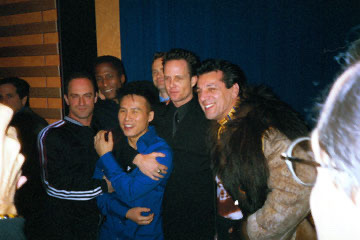
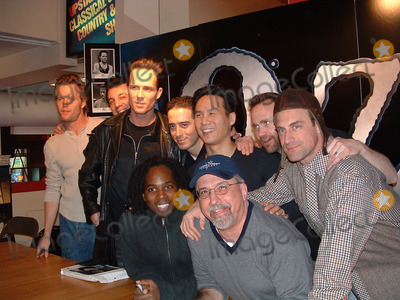


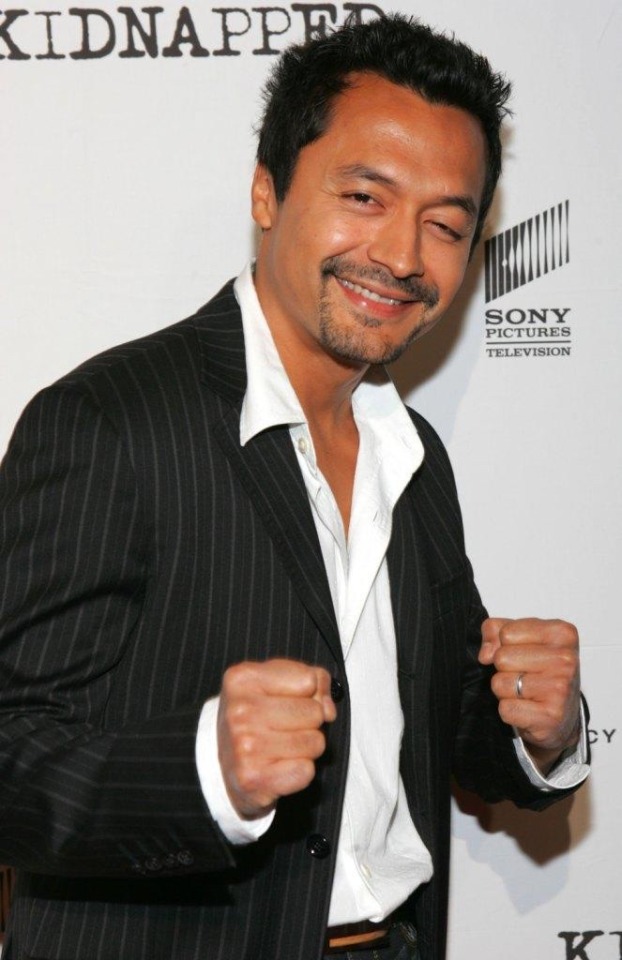
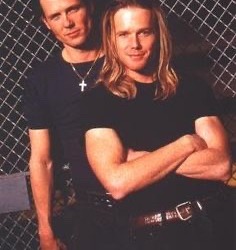
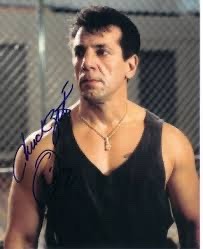
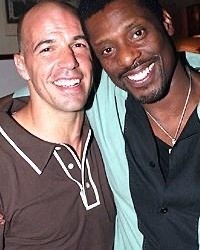
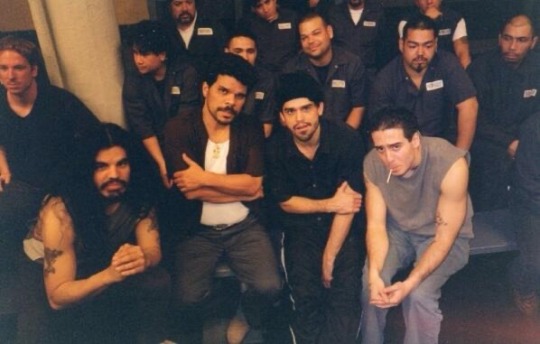
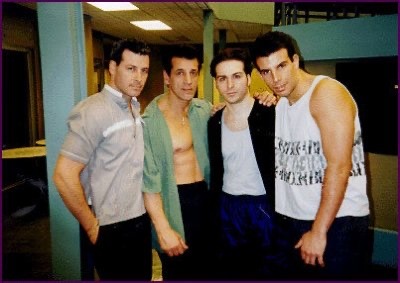
Just some fun set and off set pics of our favorite guys❤️❤️❤️
#hbo oz#oz meme#miguel alvarez#Kirk Acevedo#kirkkkkkk my guy#much love for this show#would reccomend#even with all the pee pees lol#(especially because of all the pee pees)
11 notes
·
View notes
Text
Before work
My ipad is currently full of started fics that haven’t gone anywhere. I can’t seem to contain the muse into writing a short in a finished form. So I’m posting what I wrote this morning, which goes nowhere, doesn’t do or reveal anything, and just starts a fic that I don’t have time at the moment to work out where it is going.
So here be a bit of writing. Other than that, I have no idea what it is.
-o-o-o-
Virgil kicked himself for not changing before looking for his brother. The quiet of the library was ever so accusatory at his grubby t-shirt and jeans, he had the urge to turn around and exit the building until he could find more appropriate clothing.
But Scott had been concerned and with Virgil so happily working a job in the same town as John just happened to be studying, Virgil was his goto to check up on their little brother.
You know, the one who stared into the sky and forgot to answer his phone.
Scott was definitely working on his first grey hair.
It was late and to be honest, Virgil was surprised the library was even open, but then the sign on the door claimed access at all hours because knowledge was king and governor to the free. He couldn’t argue with that.
The foyer sported the expected customer service desk and beyond, a sea of computer terminals. Multiple heads moved and made the sounds of life at the level of barely a murmur. One or two looked up at Virgil’s entrance as if to accuse him of existing.
He nodded at the librarian at the desk and ignored the rest, striding past the terminals and down to the shelves of books.
John loved books and Virgil couldn’t blame him. There was so much to be found between pages of many kinds.
No doubt Johnny would be in the local history section. And as Virgil navigated between the shelving, sure enough, there sat his brother, by himself, staring at a rebound paper book with soft edges and yellowed pages.
“John?”
The astronaut startled before frowning. “Virgil? What are you doing here?”
“You didn’t answer your phone.”
John blinked and reached into his pocket pulling out the star-studded, multi-adapted-for-everything device he used as a phone and frowned at it.
“Oh, sorry, I turned it off.”
Virgil didn’t let out the sigh. Instead he sat down at the table opposite his brother. “What’s up?”
John glanced up at him and put down his phone. “Nothing.”
Virgil flattened his gaze. “Really.”
And yeah, John wasn’t looking at him.
“Want to try that again?”
That earned him a glare. “I’m fine, Virgil.”
TBC?
#thunderbirds are go#thunderbirds#thunderbirds fanfiction#virgil tracy#john tracy#younger tracys#nuttyfic#focus damnit#gonna be late for work this morning as I’m not dressed and am supposed to be leaving right now
42 notes
·
View notes
Text
Black Butch Flag and Butch Symbol by thegenderthieves
Continuing to repost some of my friends' stuff from their terminated accounts so that it's more easily findable (with their permission ofc) All text is pasted straight from the original coining!

I (thegenderthieves) made a flag for the black butch community, it represents all black butches including the bulldyke and stud labels!
Black butches are so important to the sapphic and lesbian communities and we deserved a flag that unites all of us! It’s simply called the black butch community flag, or black butch flag
The colours are inspired by the dyke flag (you don’t need to have reclaimed dyke to use this flag ofc!), and both of the most common butch flags (orange/yellow, and blue/purple flags)
Meaning:
Black - black history and black sapphic history
Magenta/purple - lesbian and sapphic history, love of women and non-men, sapphic power
Dark purple - inclusivity of all sapphics, including trans, non-binary, mspec, aroacespec, and other sapphics
Light orange - butchness, gender non-conformity, solidarity and unity
Bull with labrys axe symbol - strength, rebellion, and liberation
My butch symbol (not black-exclusive):


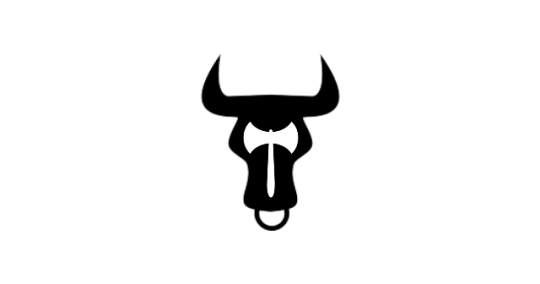
My butch symbol is free to use on other flags (with credit). Both the symbol and flag can be made into emojis and used elsewhere without credit as long as you’re not claiming them as your own or using the flag for yourself as a non-black person!
Version with no symbol:

#coining post#butch#sapphic#lesbian#pride flag#mogai#lgbtq#positivity#pride#queer#lesbian pride#lesbian flag#wlw#nblw#bulldyke#dyke#butch lesbian#black butch#black dyke#black#poc#black joy#stud#butch bisexual#butch sapphic#futch#new pride flag#flag coining#lavender labrys flag#labrys
47 notes
·
View notes
Text










20th century Sheffield bowie knives
A BOWIE KNIFE, WILKINSON, LONDON, EARLY 20TH CENTURY with robust blade formed with a clipped-back point, etched with the maker’s details, Royal warrants to the King and Prince of Wales, and ‘Finest sword steel England’, German silver guard, natural staghorn scales retained by five rivets, in its scabbard,14.8 cm blade
A BOWIE KNIFE, T. ELLIN & CO., SHEFFIELD, 20TH CENTURY with straight blade formed with a clipped-back point and filed back-edge, etched ‘I Never Fail’ in large capital letters on one face, signed recessed rectangular ricasso, shaped steel guard, and blackbuck grip with steel pommel, in its leather scabbard with iron locket and belt loop, 25.0 cm blade
A LARGE BOWIE KNIFE, ROBINSON, SHEFFIELD, AND ANOTHER, SHEFFIELD WORKS PHILADELPHIA, SECOND HALF OF THE 20TH CENTURY the first with robust blade formed with a clipped-back point, signed recessed ricasso, iron guard, natural staghorn grip and turned iron pommel; the second with broad blade with clipped-back point, signed ricasso, brass hilt and horn grip studded with brass nails, the first: 25.0 cm blade (2)
A BOWIE KNIFE, GEORGE WOSTENHOLM & SON, WASHINGTON WORKS, SHEFFIELD, 20TH CENTURY with broad blade formed with a clipped-back point, stamped with the maker’s details, ‘I.XL’, and ‘The real I.XL knife’, engraved with an eagle and etched with two captioned portraits (worn), recessed rectangular ricasso stamped ‘I.XL’, German silver guard, milled copper alloy fillets, polished horn scales and vacant German silver escutcheon, 24.3 cm blade
A BOWIE KNIFE, JOSEPH RODGERS & SONS, NO. 6 NORFOLK STREET, SHEFFIELD, EARLY 20TH CENTURY with tapering blade formed with a clipped-back point, rectangular ricasso stamped with the maker’s details including cross and star mark and the Royal letters ‘ER’ divided by a crown, German silver guard with globular terminals, natural staghorn scales, vacant German silver escutcheon in its German silver-mounted leather scabbard with belt loop, 20.2 cm blade
A BOWIE KNIFE, GEORGE WOSTENHOLM & SON, WASHINGTON WORKS, SHEFFIELD, CIRCA 1960 with broad blade formed with a clipped-back point, stamped with the maker’s details, ‘I.XL’, ‘The Hunter’s Companion’, and ‘The real I.XL knife’, engraved with an eagle and with the makers name and ‘California Knife’ in gilt letters, recessed rectangular ricasso stamped with the maker’s details in full, German silver guard, milled copper alloy fillets, natural staghorn scales and vacant German silver escutcheon, in its wooden scabbard with tooled leather covering stamped ‘I.XL’ in gilt letters and with German silver mounts, 24.0 cm blade
A BOWIE KNIFE, GEORGE WOSTENHOLM & SON, WASHINGTON WORKS, SHEFFIELD, 20TH CENTURY with broad blade formed with a clipped-back point, stamped with the maker’s details, ‘I.XL’, and ‘The real I.XL knife’, engraved with an eagle and etched and gilt with two captioned portraits of General Garibaldi and Vittore Emanuel (worn), recessed rectangular ricasso stamped with the maker’s details in full, German silver guard, milled copper alloy fillets, natural staghorn scales and vacant German silver escutcheon, in its wooden scabbard with tooled leather covering stamped ‘I.XL’ in gilt letters and with German silver mounts, 24.3 cm blade
A CASED BOWIE KNIFE, SECOND HALF OF THE 20TH CENTURY with broad blade formed with a clipped-back point, stamped ‘Broomhead & Thomas Celebrated American Hunting Knife’ at the ricasso, German silver hit, mother-of-pearl scales, in its engraved German silver scabbard decorated with flowers, foliage and the initials ‘JB’, in a lined and fitted case, 23.8 cm blade
A BOWIE KNIFE, 20TH CENTURY with broad blade formed with a clipped-back point and stamped ’Fenton & Shore’ at the ricasso, cast copper alloy hilt comprising guard with scrolling quillons and horsehead pommel, horn grip, in its scabbard, 35.0 cm blade
A BOWIE KNIFE FOR THE AMERICAN MARKET IN MID-19TH CENTURY STYLE, 20TH CENTURY, INSCRIBED TILLOTSON, COLUMBIA PLACE, SHEFFIELD with single-edged blade with clipped-back point, etched with scrolling foliage and a scroll inscribed ‘Gold Hunter’s Knife’, rectangular ricasso stamped with the maker’s details, German silver guard and pommel, the latter embossed with a reclining lion, and mother-of-pearl scales retained by four rivets, 27.0 cm blade
tinyurl.com/yr4hd4pr
43 notes
·
View notes